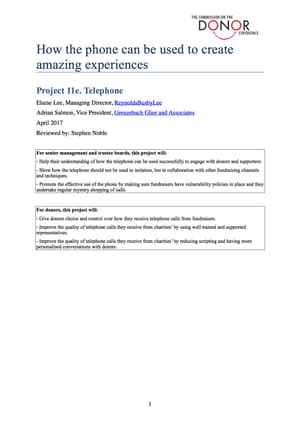CDE project 11e telephone: case study — The Bible Society
- Written by
- The Commission on the Donor Experience
- Added
- April 18, 2017
Bible Society Calling Philosophy
We started calling donors in 2010. We decided initially on a few principles that we have kept to ever since:
- We would not pay by results, but would pay a small amount per call, regardless of result. We hoped that this would prevent the callers feeling pressured to get results.
- We would not rigidly insist on drop asks, these should only be where appropriate.
- Happy donors were a priority, so every call would aim to leave the donors feel thanked.
Learnings from the last five years
We have discovered that positive responses on the telephone are consistently ten times as high as by post. This is true for people increasing their monthly gift, as well as for cash donors converting to regular giving. So telephone calling is very cost effective.
It also allows us to have a much more personal contact with our supporters, and we are often able to answer queries or special requests when calling.
We have a very low level of complaints – around twenty complaints for every 10,000 calls. Where we can, we contact those complaining, and the situation has almost always been amicably resolved when we are able to explain why we do calling.
The low level of complaints is partly because we only call where we have permission, and in recent campaigns we have endeavoured to be even clearer that people will be called.
We conducted a supporter survey in 2013, and discovered that people who were called were more likely to describe themselves as very satisfied, than those who had not been called.
The figures are below - From Bible Society Supporter Survey 2013

Calling may upset a tiny minority, but in general, it greatly increases satisfaction levels.
Called people were 35% more likely to tick very satisfied than those not-called and called people were 25% less likely to tick neither than non-called.
Note that although people reported being called several times, we almost never call supporters more than once, unless they are regular givers, and even then only every two years or so. Donors sometimes report several call attempts (that usually go through to answering machine) as being called several times, although we don’t count a call as a call unless we’ve had a proper conversation with someone. In line with industry standards we attempt calls a maximum of ten times.
Welcome calling
We trialled welcome calling in late 2016, but this was problematic due to the heavy restrictions on what constituted a marketing call, so it meant we weren’t able to check that they were happy to receive future calls, or to promote our aims and objectives. So the call was very short and an offer to provide future help if needed.
Multi-channel campaigns
The telephone has helped us to run some very successful multi-channel campaigns. We have been running these for the last three or four years. As an example, in late 2016, we produced a Scripture colouring calendar, which we advertised widely using targeted ads on Facebook. We trialled two options:
- To get their free calendar people had to give a name, address and mandatory telephone number. It was clear that they would be called, and if they didn’t want a fundraising call, then they could still get a free calendar by calling in to the office for one instead. (Form Version A)
- People could order a free calendar, but the telephone number was optional, and the form asked people to give the number if they were happy to be called. (Multipage form Version B)
(Images of forms included at the end)
Those who had filled in the form with a mandatory telephone number responded to a direct debit request at a rate 26.5% higher than those who had given it voluntarily. However, it is a slightly mixed picture. Although the form with the telephone number as a required field did do better in terms of DD response rate, it was notably harder to get through to these people. The contact rate was 32% lower for this segment. But the overall return for the mandatory form (once cost of calls is factored in) remains better.
On the mandatory form we tried hard to make it absolutely clear that they would receive a telephone call, and even put an extra note under the box saying ‘Enter the number you want us to call’.
We also did a simultaneous campaign on DRTV. People texting the keyword would get a call-back and we would then take their name and address, and tell them more about our work. Interestingly, the DRTV campaigns we have done have had a very significantly higher conversion rate than the campaigns where we call people after they have received their gift. The difficulty with this method is that the initial costs of advertising are very high, but it does show that this recruitment method has potential if we can increase the number of responses or reduce the cost of advertising.
Version A: Mandatory telephone form

Version B: Optional telephone number above and below (multipage form)





















